In life, it can feel like things happen randomly, without causation, and with little or no meaning.
The human brain, though, needs meaning. We need to understand why things are going badly for us so we can avoid it or why things are going well, so we can do more of whatever’s working.
This is why humans love stories. Stories give us a sense of purpose, meaning, and shape, and they do that through story arcs.
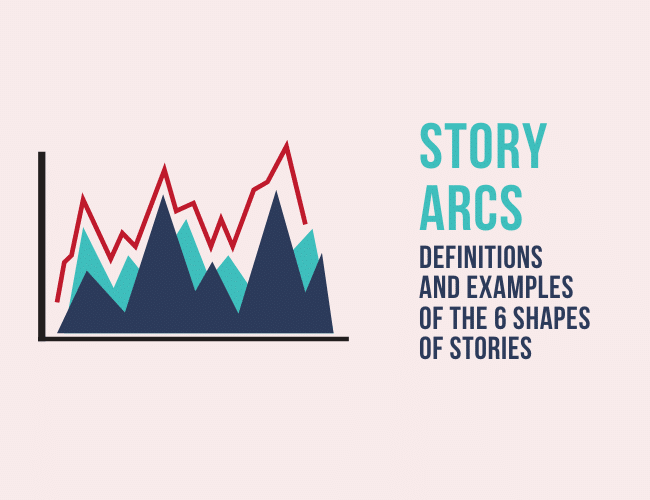
In stories, we get to see the cause-and-effect connections between otherwise random events. We get to experience the deeper meaning in life. We get to see through the chaos of real life and see the underlying pattern.
The literary term for this pattern is story arc, and humans love story arcs.
In this article, we’re going to talk about the definition of story arcs, look at the six most commonly found story arcs in literature, talk about how to use them in your writing, and, finally, study which story arcs are the most successful.
Definition of Story Arc or Narrative Arc
The arc of story, or narrative arc, describes the shape of the change in value, whether rise or fall, over the course of the story.
That’s the definition, but what does it actually mean? Let’s break it down.
Story Arcs Rise and Fall
Stories change. If there is no rise or fall in a narrative, it isn’t a story. It’s a series of events.
Maintaining the status quo won't engage readers. It's the rise and fall of characters’ fortunes that interests us more than anything else.
This change, the rise and fall in a story, can be plotted on a graph to form a curve shape line.
And when you graph them, you begin to see patterns across all forms of story.
Here is a simple graph of a dramatic arc that Kurt Vonnnegut describes as “Man in a Hole”:
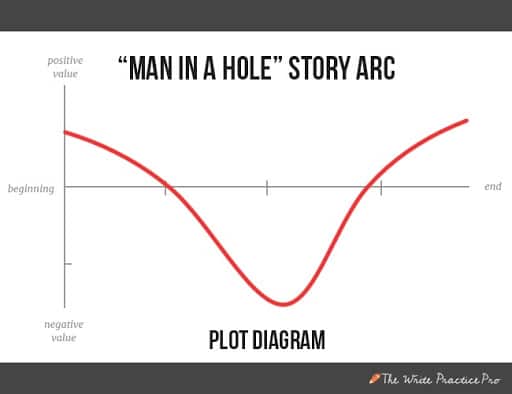
The x-axis of the graph describes the chronology of the narrative structure and the y-axis describes the positive or negative value the main character experiences.
That means that story arcs can also be character arcs, illustrating the character development that occurs throughout the plot.
However, while all character arcs are story arcs, not ALL story arcs are character arcs. In other words, some story arcs illustrate things separate from the main character's development, which we'll talk more about in the section “Story Arcs Measure Values” below.
Want to write a story? Get The Write Plan Planner to write your way from idea to finished book.
You'll start by creating a plan for your story (including drawing your story's arc!). Then, you'll track your writing each day until you reach the final page. It's the planner designed by writers, for writers, so you actually finish your book.
The 6 Primary Story Arcs
Story arcs, of course, do not always follow such simple graphs. In fact, story arcs can often look more like this than a smooth curve:
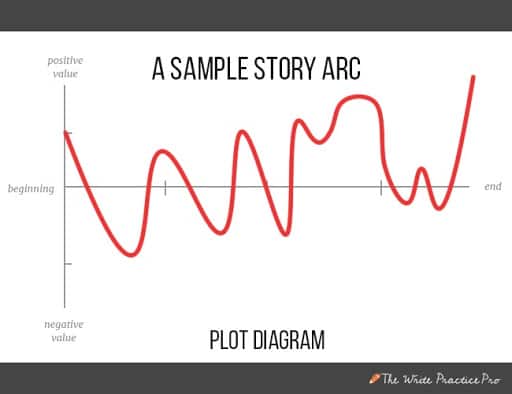
Yes, stories must change, but that doesn’t mean they all change in the same ways.
But when you compare the story arcs of the best stories throughout history, patterns begin to emerge, and you find that these arcs are much more uniform than you might think.
That’s what Andrew Reagan and his team of researchers from the University of Vermont found after analyzing over 4,000 of the best novels from the Project Gutenberg library.
In fact, they found that stories fall into six primary arcs, which I’ll list below. You can find the full study, Toward a Science of Human Stories, here (the part we’re talking about begins on page 73).
1. Rags to Riches (rise)
All stories move, but some stories only have one movement.
In the “Rags to Riches” story arc, that movement is a continuous upward climb toward a happily ever after.
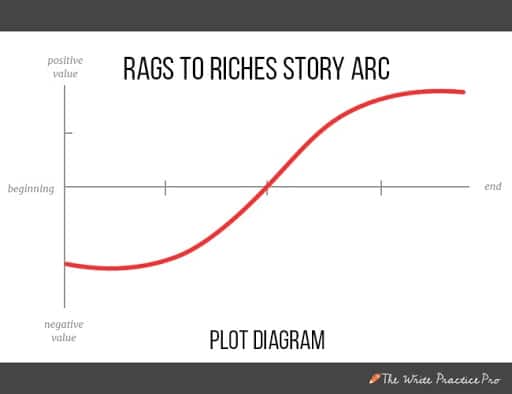
The Rags to Riches story arc is one of the most common story types; however, these stories lag in popularity, according to Reagan, the researcher from the University of Vermont, who found that other arcs were more widely read.
Examples of Rags to Riches story arcs:
- Disney’s Tangled
- A Winter’s Tale by William Shakespeare
- Pride and Prejudice by Jane Austen
- Matilda by Roald Dahl
- Holes by Louis Sachar
- The BFG by Roald Dahl
- My Fair Lady (film) / Pygmalion (play) by George Bernard Shaw
- The Great American Dream / Progress
2. Riches to Rags (fall)
As with Rags to Riches, in a Riches to Rags story, there is just one movement. However, this movement is in the opposite direction—a fall, rather than a rise.
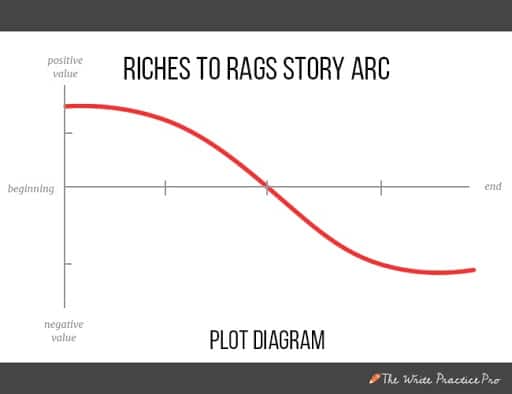
In a Riches to Rags story, the protagonist begins the plot in a fairly high place, but slowly their life devolves until by the end, their life is a ruin of its former self.
Examples of Riches to Rags story arcs:
- Catcher in the Rye by J.D. Salinger
- Animal Farm by George Orwell
- Catch-22 by Joseph Heller
- Love You Forever by Robert Munsch
- Picture of Dorian Gray by Oscar Wilde
Addiction stories or stories about mental health often fit into this structure.
3. Man in a Hole (fall then rise)
This is one of the most common and highly rated arcs, where the slope rises/falls and then rises/falls again, forming what looks like a hole. This is even an arc I used in my book Crowdsourcing Paris.

Examples of Man in a Hole story arcs:
- The Hobbit by J.R.R. Tolkien
- Alice in Wonderland by Lewis Carroll
- Disney’s Monsters, Inc.
- Finding Nemo
- “Make America Great Again,” Donald Trump’s Campaign Slogan
Many stories actually include two sequential Man in a Hole story arcs, as illustrated by this curve:
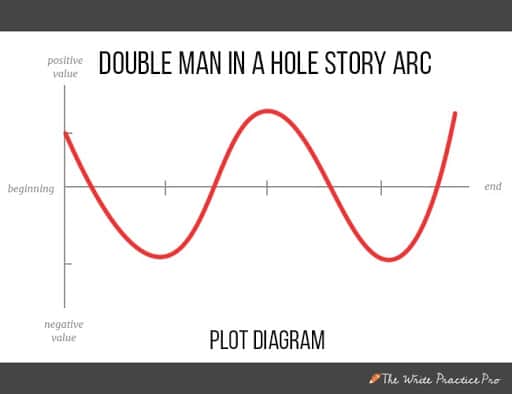
According to Reagan and the researchers at the University of Vermont, this is one of the most popular structures, and the most popular arc with a happy ending. He says in his paper:
We find “Icarus” (-SV 2), “Oedipus” (-SV 3), and two sequential “Man in a hole” arcs (SV 4), are the three most successful emotional arcs.
Examples of the Double Man in a Hole arc include:
- Harry Potter and the Prisoner of Azkaban by J.K. Rowling
- Disney’s The Lion King
- And more
Some stories even contain many Man in a Hole arcs—becoming Man in a Hole, Man in a Hole, Man in a Hole ad infinitum. Lord of the Rings and the 6,700-page online serialized novel Worm are examples of this.
4. Icarus / Freytag’s Pyramid (rise then fall)
This is the plot structure Gustav Freytag was interested in when he coined the plot structure now known as Freytag’s Pyramid (contrary to popular belief, Freytag’s Pyramid is not a universal structure for plot, but a description of a single arc). For more on this literary concept (and how it’s since been misunderstood), see our full Freytag’s Pyramid guide here.
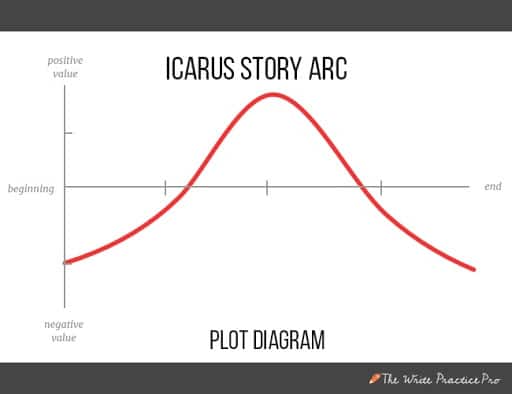
The Icarus arc, named after the cautionary Greek story about a boy who escapes imprisonment on an island by constructing wings made of wax and ultimately flies too close to the sun, is one of the most popular story arcs.
Examples of the Icarus story arc include:
- Hunger Games by Suzanne Collins
- The upcoming novel Pluck by J.H. Bunting (me!)
- Macbeth by William Shakespeare
- Disney’s Peter Pan
- The Old Man and the Sea / A Farewell to Arms by Ernest Hemingway
- The Fault in Our Stars by John Green
- Jurassic Park by Michael Crichton
- Titanic (film)
- Great Expectations by Charles Dickens
- The Great Gatsby by F. Scott Fitzgerald
- The Great Santini by Pat Conroy
If the word “great” is in the title, you know you’re in for a sad ending! This is a popular story structure with literary writers, and tends to be a staple structure for many classics.
5. Cinderella (rise then fall then rise)
The Cinderella arc, like Rags to Riches, is one of the most common arcs, often found in love stories, sports stories, Disney movies, and other stories with happy endings.

If you’re writing a Disney movie, there’s a good chance it’s going to be Cinderella.
This is also commonly the arc of stories that follow the Hero's Journey. While the hero's journey can be more complicated than a single arc, most fit the Cinderella arc.
Examples of Cinderella story arcs:
- Disney’s Frozen
- Disney’s Up
- Dreamwork's How to Train Your Dragon
- Jane Eyre by Emily Bronte
- Disney’s Pinocchio
- Disney’s Aladdin
6. Oedipus (fall then rise then fall)
The Oedipus arc is one of the most difficult structures to pull off, but it’s also one of the most highly read structures.
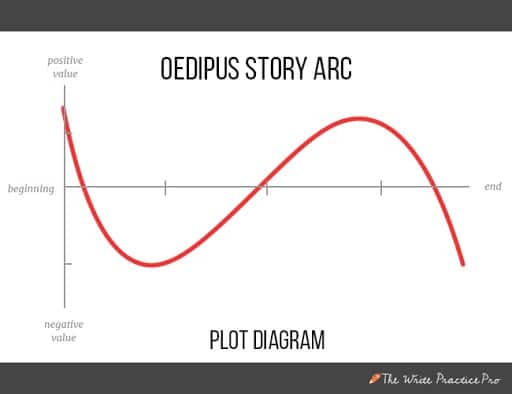
Examples of the Oedipus story arc include:
- Moby Dick by Herman Melville
- Frankenstein by Mary Shelley
- And Then There Were None by Agatha Christie
- Lolita by Vladimir Nabakov
- The Sun Also Rises by Ernest Hemingway
- Gone with the Wind by Margaret Mitchell
- The Godfather by Mario Puzo
- Gone Girl by Gillian Flynn
- Hamlet by William Shakespeare
Top 3 Best-Selling Story Arcs and Character Arcs
You now know the six story arcs, but there are three that researchers have shown to be the arcs of more bestselling stories. Watch the video to learn what they are:
How Story Arcs Fit Dramatic Structure
Dramatic structure describes the elements of a story's movement, and each of the above story arcs incorporates the dramatic structure. At The Write Practice, we identify six plot points, or elements of plot:
Note that many people include the falling action in their dramatic structure. I don’t include it because I believe the term “falling action” is misleading and really only appropriate for Freytag’s narrow definition of the tragic, Icarus structure, not a modern three-act story structure. You can read more about this in my falling action article.
Here’s how these elements of dramatic structure fit into the Rags to Riches Story Arc:
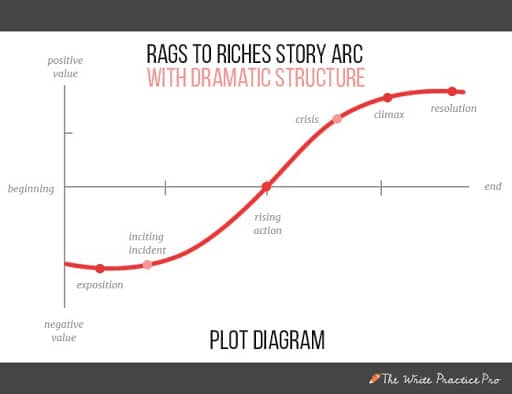
In this arc, the exposition has little to no movement and is primarily to acclimate the reader to the world of the story and its characters.
The inciting incident begins the upward movement.
The rising action describes the upward motion of the movement.
The combination of the dilemma, where the character must make a critical choice, and climax, the moment of highest conflict and action, is the point of the peak—the make-or-break moment when things could either continue to improve or reverse.
Last, the denouement or resolution wraps up the plot at the end of the story with one or two scenes of relative stability. Denouement means untying in French, and in these final moments, the loose ends of the plot are tied up.
These components of dramatic structure can be found in every arc, and are part of what gives each arc their structure.
Story Arcs Can Also Fit In A Three-Act Structure
The Greek philosopher Aristotle gave the first recorded writing tip, saying that stories should have a beginning, a middle, and an end. Not the most profound advice ever, but over time, this evolved into the three-act structure, the most commonly used structure today (as opposed to the five-act structure, which you can learn more about here).
The three-act structure combines perfectly with story arcs, allowing flexibility in terms of the arc you're trying to create while also providing a structure that flows with the reader's expectations.
While this is not a law, commonly twenty-five percent of the arc is in the first act, fifty-percent is in the second act, and the rest of the story fits into the final twenty-five percent of the third act.
More complicated arcs may actually have nine acts; in other words, they have three three-act structures.
Longer series or epics, stories with arcs that combine to form more complicated patterns, may even have twelve, eighteen, or even twenty-seven acts.
Story Arcs Measure Values
A story’s rise and fall in value can be expressed generally in terms of “fortune,” but you can also get more specific by measuring a story’s movement based on six different story values.
You’ve heard that your story needs conflict, but what does that actually mean? Because the kind of conflict stories need is (probably) not more fistfights and loud arguments (although, depending on the story, that might not hurt!).
No, the kind of conflict your story needs is between one value and its opposite.
Which values?
A good story rises and falls on the spectrum of one of six different values, according to Shawn Coyne, the author of Story Grid. The six values, which follow Maslow’s Hierarchy of Human Need, are as follows:
- Physiological. The value of food, water, air, warmth, and rest. Life vs. death.
- Safety. The value of personal and group security. In story terms, life vs. a fate worse than death.
- Love/Belonging. The value of intimate relationships and friendships. Love vs. hate.
- Esteem. The value of personal prestige and accomplishment. Accomplishment vs. failure.
- Self-Actualization. The value of reaching your potential. Maturity vs. naiveté.
- Transcendence. The value of becoming more than yourself. Right vs. wrong.
The rise and fall of these values dictate the rise and fall of the arc.
For example, in an adventure story (Man in the Hole arc) set in space like the film Gravity, where the core value is physiological survival, you would measure the arc based on this life vs. death metric.
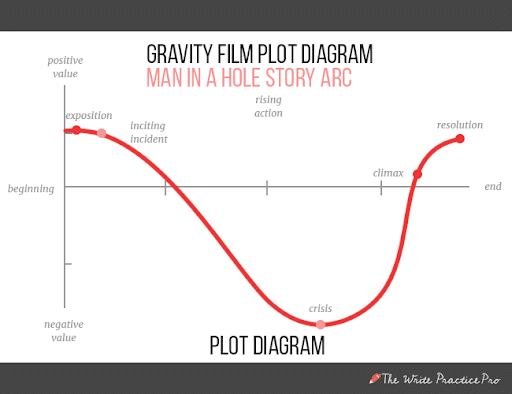
Let’s break this arc down, analyzing the rise and fall of the life vs. death value throughout the key moments in the story:
***Spoiler Alert***
Exposition
Dr. Ryan Stone (Sandra Bullock) and astronaut Matt Kowalksi (George Clooney) are on a space walk on the Hubble Space Telescope.
Life vs. Death value measure: stable.
Inciting Incident
A missile strike causes a chain reaction of space debris that threatens to destroy much of the spacecraft around the planet.
Life vs. Death value measure: a threat of death appears.
Rising Action
The space debris field begins to destroy spacecraft, including Stone and Kowalski’s ship, and they have to escape to the International Space Station. But the spacecraft ISS has been damaged, and they have to travel to the Chinese space station. While en route, Kowalski sacrifices his life to save Stone. Other space shenanigans happen until Stone is out of options for survival.
Life vs. Death value measure: inching closer and closer toward likely death.
Dilemma
The sole survivor of the debris field and trapped in a Soyuz capsule without fuel, Stone has to choose whether to end her life or keep working to survive. Initially, she decides to turn off life support, but as she is losing consciousness, a vision of Kowalski gives her a final solution to reach the working Chinese re-entry capsule.
Life vs. Death value measure: near death.
Climax
Stone reaches the Chinese re-entry capsule just as the space station is about to crash into the atmosphere. She unlocks from the station and is descending to Earth when a fire starts. After she lands safely in a lake, she has to evacuate the capsule immediately because of the smoke and nearly drowns before finally swimming to shore.
Life vs. Death value measure: near death but survival becoming a slim possibility.
Denouement
Stone takes her first steps on Earth, thanking Kowalski, and as she watches the debris burn in Earth’s atmosphere, a helicopter flies overhead, signaling her rescue.
Life vs. Death value measure: survival by a small margin!
***End Spoiler Alert***
Notice how the story moves from virtually no chance of death to death being almost a certainty to the resolution, where survival seems even more precious because of how close the protagonist came to death.
The story moves the value from the positive form to the negative, and, depending on the value, back again. The story’s arc is created through this rise and fall movement.
This same arc can be used to tell a love story, a performance story, or even a coming of age story. The arc stays the same, but the value being represented by the arc changes.
Can You Have Multiple Story Arcs?
Yes! In fact, most stories have multiple arcs.
Most novels and films are made by combining three plots, three different value scales like those listed above:
- Main plot
- Internal plot
- Subplot
Here's the key point:
Each plot must have its own arc
That means if you're writing an adventure story with a coming of age internal plot and a love story subplot — like The Alchemist, a quarter of the Harry Potter series, A Tale of Two Cities, The Da Vinci Code — then you will have three different arcs, one for each plot.
Short stories only have one arc
Conversely, if you're writing a short story, it only has one arc. And, usually, that arc will only have one or two movements.
Sometimes there are separate character arcs for each POV character
If you have multiple point of view characters or protagonists, you may have multiple story arcs—one for each character.
This is one reason to avoid having multiple protagonists, because it complicates the story, sometimes creating more arcs than you the writer (and your readers!) can keep track of, especially if you're relatively inexperienced.
(If you really think your story benefits from multiple protagonists, make sure it checks off these three qualifications.)
Epics, novel or film series, and episodic stories have many arcs
Some stories will have more arcs, especially series, epics, or episodic stories.
Soap operas, for example, often have so many arcs going that if you find yourself in the middle of a random episode, it will feel extremely chaotic.
Often, episodic TV series will have one or two long arcs that last the whole series, while each episode has two or three smaller arcs.
Sitcoms, according to Noah Charney, often follow this structure:
- Teaser (exposition) – one to three minutes
- Trouble: Story A (inciting incident) – minute three
- Trouble: Story B (inciting incident) – minute six
- The Muddle: Story A (rising action, dilemma) – minute nine
- The Muddle: Story B: (rising action, dilemma) – minute twelve
- The Triumph/Failure: Story A (climax) – minute thirteen
- The Triumph/Failure: Story B (climax) – minute fifteen
- The Kicker: Story A + B (denouement) – minute nineteen
In sitcoms, these two or three (when a C story is involved) arcs are usually independent from the overall arc of the series. However, occasionally, one or both of these arcs involve a longer running master arc of the show, carrying on plots that have been previously established.
A big reason for this is because, unlike in novels, we don't want our favorite characters in sitcoms to change that much from episode to episode. While main characters like Sheldon in the Big Bang Theory do undergo character transformation in the series, his major quirks remain consistent episode to episode.
This also provides more opportunities for main characters to frequently fail as they attempt to achieve their episode goal, which provides more opportunities to drop jokes that pull at the character's steadfast personality traits and flaws.
Likewise, the Ross + Rachel arc from the sitcom Friends contains many movements over hundreds of episodes built up in ten years, but it was all done in one arc, usually using the same structure as the one above.
How to Use Story Arcs in Your Writing: 6 Writing Tips
Now that you understand the six main arcs and how the shapes of stories interact with a story’s core value, how do you actually use this information to write great stories?
Here are five writing tips for using story arcs in your writing:
1. Above all, make sure your story moves.
It can move up, it can move down, it can move up and then down. But it must move, and that movement must begin early.
A narrative that stays the same is not a story but an account of events.
2. In the first draft, don’t worry about matching your story to a particular arc.
You may know what your arc is when you start writing, and you may not.
Don’t worry too much about it. Just tell your story (and make sure that story moves).
Don't get me wrong: you can use these arcs as templates, especially if your story idea is somewhat formless right now. But if you have a clear idea of your story, don't worry too much about whether it matches the arcs above.
3. In the first draft, do worry about finding your core value.
While you don’t need to worry about finding the right shape of your story when you start writing, you should try to discover the core value, the y-axis that your story will move on.
If you can discover your core value (see the list of six values above for the options), you will be much more equipped to making sure it moves the way it needs to.
And while you may choose more than one value—perhaps a value for a subplot or the internal genre—if you try to move your story on too many values, it will become muddied and will be very hard to work with in your second draft.
Above all, keep it simple. You can always write another book, but a book that’s trying to do too much can easily become unworkable.
4. Know your genre and form and consider your arcs accordingly.
Different forms have different arc conventions.
As we explored above, most novels and films have three arcs, most sitcoms have two arcs, and most short stories, on the other hand, have just one arc.
Genres have different conventions as well. Fantasy stories and romance stories often follow the Cinderella arc. Science fiction stories often use the double man in a hole arc. Literary novels often use the Oedipus arc.
Study your genre and form to know which arcs are most common. If you find that they're commonly using one specific arc, it doesn't mean you're forced to use it too. But it should inform how you approach your arc choices, if you decide to use a different one.
5. Write toward the dilemma.
When you’re writing a first draft, you don’t need to know everything that’s going to happen.
If you’re a pantser rather than a plotter, you might not know anything that happens.
But the best thing you can do is to write toward the dilemma.
The dilemma is the primary turning point in a story. It is the moment when a character is presented with a difficult choice that will determine his or her fate.
This moment is usually found at the very bottom of a dip in a story arc or the very top of a peak. It will be followed almost immediately by the climax.
If you can find that dilemma, you will have found your story.
Everything in a story builds to the dilemma.
For more on how to discover the dilemma in your story, read my full guide on literary crisis here.
6. In your second draft, find each arc and enhance them.
While you don’t need to know the shape of your main story arc or sub-arcs in your first draft, after you finish your first draft and before you start your second draft, find your arc.
What is its shape? How does it rise and fall? Does it fall enough? Does it rise enough? Is there enough movement?
The purpose of the second draft is to enhance your arc, to make it more pronounced, smoother, and more effective.
All Good Stories Have an Arc
Good stories are about change, and thus all good stories have an arc.
By finding the arc in your story, and making that arc better, you can give your readers what they want: meaning.
All humans need meaning. While the world often can feel confusing, chaotic, and meaningless, the role of the storyteller is to help people find meaning in their lives.
This is why humans love stories.
And soon, it’s why readers will love your story.
Which of the six story arcs is your favorite? Which story arc do you want to use for your next book? Let me know in the comments section.
Have a story arc you'd love to turn into a bestselling novel, but not sure how to make it to “The End”?
We've helped thousands of writers finish their books, and we'd love to help you, too. In 100 Day Book, you'll start and finish your book in—you guessed it—100 days. Check it out and join our next semester:
PRACTICE
Let’s practice using story arcs with a creative writing exercise. Here’s what we’re going to do:
- Choose one of the six story arcs: Rags to Riches, Riches to Rags, Man in a Hole, Icarus, Cinderella, Oedipus.
- Write a six-sentence story based on that arc using the six elements of dramatic structure: exposition, inciting incident, rising action, crisis, climax, and resolution.
- Then, set your timer for fifteen minutes and expand your six-sentence story as much as you can.
When you finish, Write Practice Pro members can post in the Pro Practice Workshop here.
Not a member yet? Check out how to join here. There's even a free option! We'd love to have you join our community of practicing writers.
Joe Bunting is an author and the leader of The Write Practice community. He is also the author of the new book Crowdsourcing Paris, a real life adventure story set in France. It was a #1 New Release on Amazon. Follow him on Instagram (@jhbunting).
Want best-seller coaching? Book Joe here.
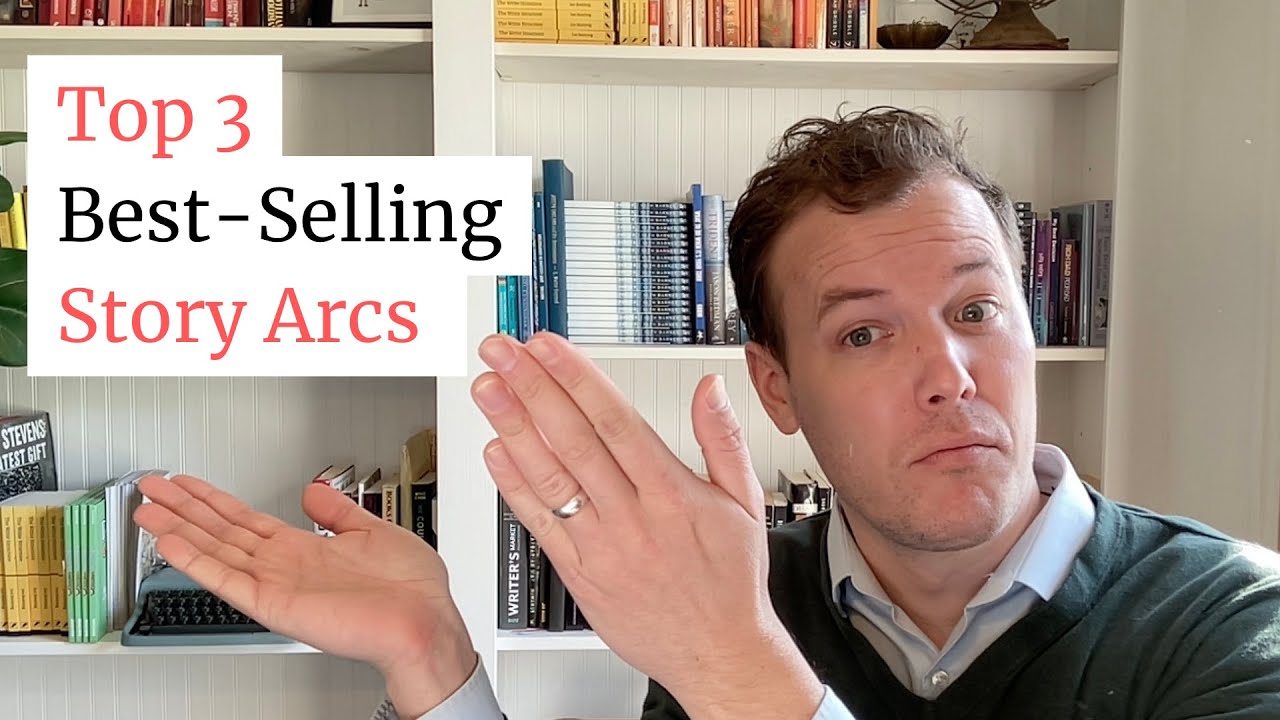




Thank you so much for this article and video. I have been having a difficult time unstanding this concept, wrongly thinking there was just one arc. You have clarified the elements of “arc” very well, and now I will be able to make my story move more appropriately.
Thank you for sharing.
It is very important for the new writers, thank you so much
Shaping a story is like crafting a Beach Buggy Racing adventure—each arc fuels momentum. Whether it’s “Rags to Riches” or “The Hero’s Journey,” your racer faces twists, turns, and turbo boosts. Just as powerful narratives need structure, every racing lap needs rhythm, climax, and the ultimate finish line triumph!
beautiful stories.
Thanks, that’s very enlightening.